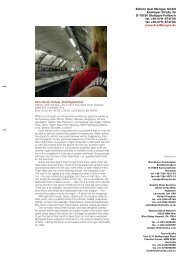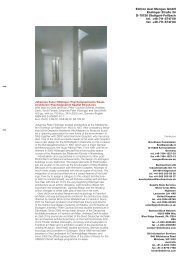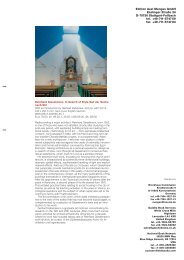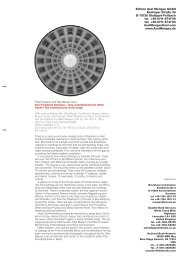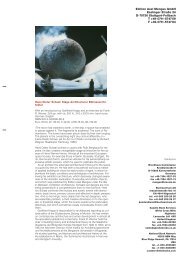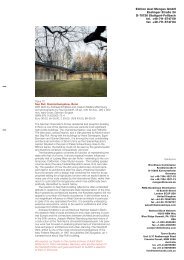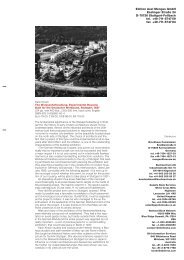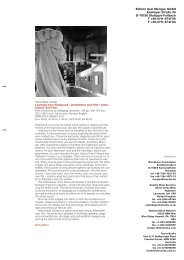Bruno Paul - Edition Axel Menges
Bruno Paul - Edition Axel Menges
Bruno Paul - Edition Axel Menges
You also want an ePaper? Increase the reach of your titles
YUMPU automatically turns print PDFs into web optimized ePapers that Google loves.
(academy and exhibition building) on the Brühl Terrace above the Elbe. The academy building, a<br />
temple of art crowned by a faceted dome and gilt bronze statue of fame, was an elaborately ornamented<br />
pastiche of historical architectural forms designed by Constantin Lipsius. A popular<br />
building and well-known in Dresden, it was a source of considerable pride. 29 It was also a perfect<br />
symbol for the academy and its school. At the end of the nineteenth century, the German royal<br />
academies were philosophically and methodologically aligned with an inherently conservative interpretation<br />
of the fine arts. »The teaching methods were largely those of the eighteenth and early<br />
nineteenth centuries. The centre-piece of the instruction given was still the drawing from plastercasts<br />
for the beginners and from the living model posing à l’antique for the advanced students«,<br />
Nikolaus Pevsner later wrote. 30 Such a refined and mannered approach to artistic education provided<br />
a counterpoint to the emphasis of the schools of applied arts on the education of tradesmen<br />
working in the minor arts. The belief in common principles applicable to all forms of artistic<br />
expression was a radical notion in 1892, and contrary to the conservative policies of the Saxon<br />
academy. <strong>Paul</strong> did not have long to absorb its ideology, however, since he departed within a year<br />
of his enrollment, without recording the names of his professors or the focus of his study. 31 Once<br />
he decided to become an artist, he pursued his objective with a determination wholly lacking in<br />
his earlier schooling. By the winter of 1893, <strong>Paul</strong>’s ambitions turned his attention from Dresden to<br />
Munich, a city whose reputation as a center of the arts then rivaled that of Paris.<br />
Munich<br />
In 1894, more painters and sculptors lived and worked in Munich than in any other German city. 32<br />
This was the era of the radiant Munich immortalized by Thomas Mann in his 1902 novel Gladius<br />
Dei; Schwere Stunde, the city of dreams (Traumstadt) of Peter <strong>Paul</strong> Althaus, the Schwabylon of<br />
the satirist Roda Roda. The preeminence of Munich as a center of the arts was sufficiently respected<br />
in Central Europe to allow the city’s large population of resident artists to enjoy an unusually<br />
high standard of living. The opportunities available in Munich provided a powerful attraction<br />
to the twenty-year-old <strong>Bruno</strong> <strong>Paul</strong>, and to innumerable other aspiring artists. In his fragmentary<br />
memoirs, <strong>Paul</strong> recalled his years in the city. »In the last three decades before 1900«, he wrote,<br />
»artistic and intellectual tensions found a point of focus in traditional, old-Bavarian Munich.« He<br />
praised the conditions of peace and self-sufficiency prevailing in the city at the end of the nineteenth<br />
century and conducive to supporting a vibrant and diverse community of artists. In Munich,<br />
he noted, »the historical styles slowly faded. At the same time, the emerging artistic trends<br />
towards realism, contemporaneity and abstraction found opportunity and support.« 33 It was these<br />
developing trends that drew <strong>Paul</strong> to Munich, and that made the city the center of Germany’s artis-<br />
4. Kunstakademie und Kunstausstellungsgebäude<br />
Dresden, circa 1920. The academy building on the<br />
Brühl Terrace (left foreground) was designed by<br />
Constantin Lipsius and completed in 1894.<br />
5. Drawing from life, undated.<br />
6. Marienplatz, Munich, circa 1895. The city center,<br />
as it appeared upon <strong>Paul</strong>’s arrival from Dresden.<br />
tic avant-garde. Schwabing, the artists’ quarter of Munich, was the German Montmartre, and at<br />
the edge of Schwabing stood the Königliche Akademie der bildenden Künste (royal academy of<br />
fine arts), the most prestigious school of art in the nation. Each year more than five hundred students<br />
came to the academy from Europe, Asia and the Americas to learn the techniques of the<br />
»Münchener Malerei«, the Munich painting admired throughout the world.<br />
<strong>Paul</strong> enrolled as a student at the Königliche Akademie der Bildenden Künste in 1894. The<br />
nineteenth-century matriculation book of the academy has survived, and his name appears<br />
among the students registered in the spring of that year. He was identified as student number<br />
1246, <strong>Bruno</strong> <strong>Paul</strong> of Seifhennersdorf in the kingdom of Saxony, son of a Protestant merchant. His<br />
age was listed as twenty years, and he was referred to as a student painter, assigned to the atelier<br />
of <strong>Paul</strong> Höcker. This brief record, noted by hand in the registrar’s old-fashioned script, marked<br />
the end of <strong>Paul</strong>’s provincial childhood.<br />
<strong>Paul</strong>’s professor at the academy, <strong>Paul</strong> Höcker (1854–1910), was himself a young and progressive<br />
artist, one of the one hundred and seven original members of the Verein bildender Künstler<br />
Münchens »Sezession« (the Munich secession) founded in 1892. 34 His work as a painter demonstrated<br />
the realism, contemporaneity, and abstraction that <strong>Paul</strong> equated with an emerging modernity.<br />
When he enrolled in Höcker’s atelier and subsequently joined the secession, 35 <strong>Paul</strong> entered<br />
the circle of Munich’s avant-garde. On the cusp of the twentieth century, Höcker and his fellow<br />
secessionists led a movement committed to the reconciliation of modern art and modern life.<br />
The Munich secession to which <strong>Paul</strong> belonged was the first such organization of progressive<br />
artists in Central Europe, and was allied with the separatist artistic movements in France that had<br />
nurtured the development of modern European painting. 36 Its establishment was motivated by a<br />
growing dissatisfaction by the more progressive members of the Münchener Künstlergenossenschaft<br />
(association of Munich artists) with the policies governing the exhibitions staged by the association.<br />
Many of the early members of the secession were inspired to join by practical considerations,<br />
the prospect of better opportunities to display and sell their works promised by the secession’s<br />
policy of smaller and more selective exhibitions. Nevertheless the executive committee of<br />
the secession advocated elite and artistically pure (reinkünstlerische) exhibitions rather than the<br />
populist policies of the Künstlergenossenschaft. The ideal of artistic purity was, inevitably, associated<br />
with emerging trends in creative expression.<br />
Höcker’s work exemplified the prevailing character of the secession. Initially he had specialized<br />
in traditional genre paintings and in portraits. During the years when <strong>Paul</strong> was under his instruction<br />
at the academy, his paintings displayed the lyrical qualities of the Modernism emerging in<br />
Munich art during the last decade of the nineteenth century. The catalog of the »World’s Columbian<br />
Exhibition« of 1893, in which Höcker participated, described the characteristics of his work<br />
on the eve of <strong>Paul</strong>’s admission to his atelier. »The very modern note is struck by the two paintings<br />
12 13




